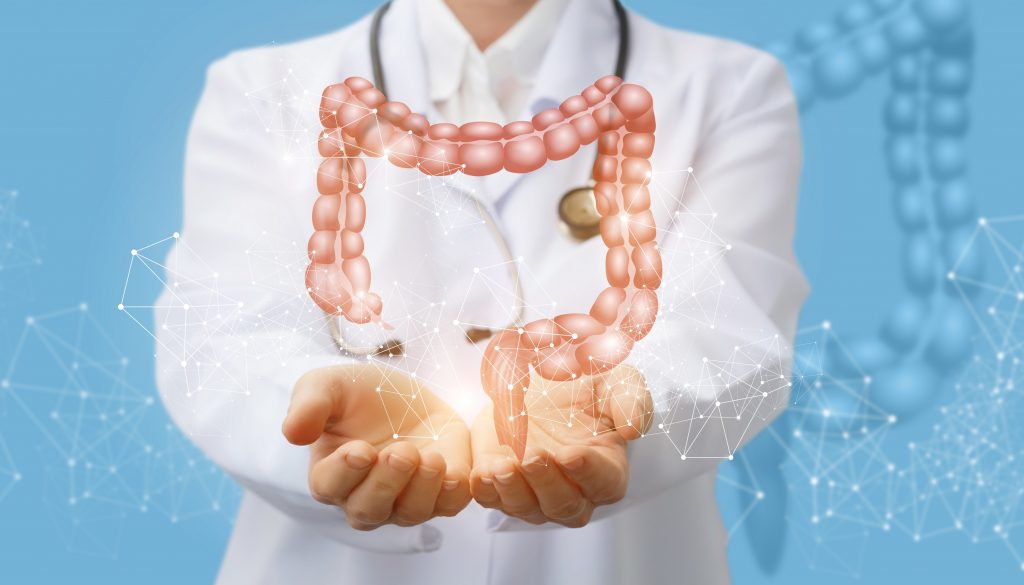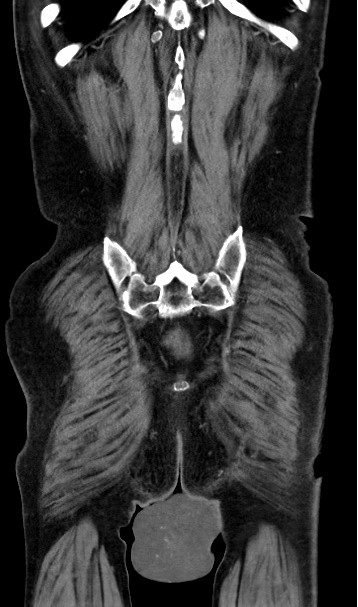- Silvia Paiardi
- Brief Report and Case Report
An atypical post colonoscopy complication: bladder herniation
- 3/2018-Ottobre
- ISSN 2532-1285
- https://doi.org/10.23832/ITJEM.2018.028

Abstract
Keywords
Inguinal hernia, bladder herniation, testicular disease, hernia reduction, colonoscopy-related complications
Abbreviations
CT: computerized tomography
Case history
An 84-years-old man was admitted to our emergency department for rising scrotum edema after a colonoscopy procedure, executed the previous day; the patient referred persistent constipation during the last 72 hours.
Further investigations and management
After a first attempt of manual reduction, the hernial status was unchanged, so it was decided to further investigate it with an abdominal computerized tomography (CT) scan.
The abdominal CT scan showed the known sigma neoplasia and a voluminous bladder herniation in the right inguinal seat, without enteral expansion above it.
A bladder catheter was temporary placed to ensure optimal emptying and the patient was referred for surgical treatment.
The patient underwent a hernial reduction surgery; during the procedure a voluminous hernial sack was found, with the bladder completely dislocated into it. After verifying bladder continence, the bladder was replaced in its natural position and the trasversalis fascia was reconstructed.
Figure 1. CT examination of the bladder herniation
Discussion
Conclusions
References
-
Whitlock EP, Lin JS, Liles E, Beil TL, Fu R. Screening for colorectal cancer: a targeted, updated systematic review for the U.S. Preventive Services Task Force. Ann Intern Med. 2008;149(9):638-658. http://www.ncbi.nlm.nih.gov/pubmed/18838718. Accessed November 7, 2017.
-
Chukmaitov A, Bradley CJ, Dahman B, Siangphoe U, Warren JL, Klabunde CN. Association of polypectomy techniques, endoscopist volume, and facility type with colonoscopy complications. Gastrointest Endosc. 2013;77(3):436-446. doi:10.1016/j.gie.2012.11.012.
-
Reumkens A, Rondagh EJA, Bakker CM, Winkens B, Masclee AAM, Sanduleanu S. Post-Colonoscopy Complications: A Systematic Review, Time Trends, and Meta-Analysis of Population-Based Studies. Am J Gastroenterol. 2016;111(8):1092-1101. doi:10.1038/ajg.2016.234.
-
ASGE Standards of Practice Committee DA, Fisher DA, Maple JT, et al. Complications of colonoscopy. Gastrointest Endosc. 2011;74(4):745-752. doi:10.1016/j.gie.2011.07.025.
-
Warren JL, Klabunde CN, Mariotto AB, et al. Adverse events after outpatient colonoscopy in the Medicare population. Ann Intern Med. 2009;150(12):849-857, W152. http://www.ncbi.nlm.nih.gov/pubmed/19528563. Accessed November 7, 2017.
-
Hawn MT, Itani KM, Giobbie-Hurder A, McCarthy M, Jonasson O, Neumayer LA. Patient-reported outcomes after inguinal herniorrhaphy. Surgery. 2006;140(2):198-205. doi:10.1016/j.surg.2006.02.003.
-
Eklund A, Rudberg C, Smedberg S, et al. Short-term results of a randomized clinical trial comparing Lichtenstein open repair with totally extraperitoneal laparoscopic inguinal hernia repair. Br J Surg. 2006;93(9):1060-1068. doi:10.1002/bjs.5405.
-
Grant AM, Scott NW, O’Dwyer PJ, MRC Laparoscopic Groin Hernia Trial Group. Five-year follow-up of a randomized trial to assess pain and numbness after laparoscopic or open repair of groin hernia.Br J Surg. 2004;91(12):1570-1574. doi:10.1002/bjs.4799.
-
Shin D, Lipshultz LI, Goldstein M, et al. Herniorrhaphy with polypropylene mesh causing inguinal vasal obstruction: a preventable cause of obstructive azoospermia. Ann Surg. 2005;241(4):553-558. http://www.ncbi.nlm.nih.gov/pubmed/15798455. Accessed November 7, 2017.


